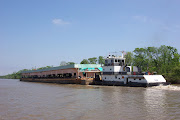 After the transmission cooler was replaced we decided to also replace the oil cooler since it was probably the same age and condition. But after removing it we found it to be moments away from a total meltdown so the decision was a good one. We ordered the parts again from American Diesel and they arrived within a couple of days. When we went to re-install it we found the oil hose sizes on the engine to be different than the hoses need for the new cooler. So we ordered the correct size from America Diesel and they too arrived in a couple of days. Although not related to the cooling system, we had planned to add an oil changer to make the oil changing process much faster and cleaner. With the hoses off for the cooler we took the opportunity to drain the oil from the crankcase, using a small pump attached to a drill. This is slow and messy but the attachment for the oil changer needs to go in the bottom of the oil pan so it had to be drained.
After the transmission cooler was replaced we decided to also replace the oil cooler since it was probably the same age and condition. But after removing it we found it to be moments away from a total meltdown so the decision was a good one. We ordered the parts again from American Diesel and they arrived within a couple of days. When we went to re-install it we found the oil hose sizes on the engine to be different than the hoses need for the new cooler. So we ordered the correct size from America Diesel and they too arrived in a couple of days. Although not related to the cooling system, we had planned to add an oil changer to make the oil changing process much faster and cleaner. With the hoses off for the cooler we took the opportunity to drain the oil from the crankcase, using a small pump attached to a drill. This is slow and messy but the attachment for the oil changer needs to go in the bottom of the oil pan so it had to be drained. We chose the X-Changer, http://www.x-change-r.com/changers/changers.shtml , for the simplicity, reliability and feedback we received from others. When we ordered the new oil hoses from American Diesel we also ordered a connection kit that they have for just this purpose. Once we had all of the parts in hand the installation was simple. We connected the kit provided from American Diesel to a plug at the bottom starboard side of the oil pan and connected the pump to the kit. The unit is easily mounted wherever is convenient in the engine compartment and the electrical connections were run to the DC panel and to its own circuit breaker. The pump is reversible and will pull the oil from the crankcase, then extract it from the fresh oil containers and put it back into the engine. We also changed the oil filter at the same time.
We chose the X-Changer, http://www.x-change-r.com/changers/changers.shtml , for the simplicity, reliability and feedback we received from others. When we ordered the new oil hoses from American Diesel we also ordered a connection kit that they have for just this purpose. Once we had all of the parts in hand the installation was simple. We connected the kit provided from American Diesel to a plug at the bottom starboard side of the oil pan and connected the pump to the kit. The unit is easily mounted wherever is convenient in the engine compartment and the electrical connections were run to the DC panel and to its own circuit breaker. The pump is reversible and will pull the oil from the crankcase, then extract it from the fresh oil containers and put it back into the engine. We also changed the oil filter at the same time. With the oil changer installed, we turned our attention back to the cooling system. Since everything was drained we also pulled the ends off the heat exchanger to inspect and clean it. There was some crud but all and all it was not too bad. With a small WOODEN dowel, each small tube inside the heat exchanger was reamed out. It is important to use a wooden dowel and not a metal one since metal can and will damage the exchanger. Once the dowel had passed completely through each of the small tubes and pushed out any growth and debris, the ends were cleaned well, and the end caps attached with new gaskets and gasket sealer. The oil cooler and related new hoses were re-attached and the oil lines reconnected. We use a good aircraft type sealer for the fittings on all of the oil and fuel lines. With the cooler re-installed, the heat exchanger cleaned out, and new hoses and clamps, the raw water intake was opened, fresh water topped off, and the engine started.
With the oil changer installed, we turned our attention back to the cooling system. Since everything was drained we also pulled the ends off the heat exchanger to inspect and clean it. There was some crud but all and all it was not too bad. With a small WOODEN dowel, each small tube inside the heat exchanger was reamed out. It is important to use a wooden dowel and not a metal one since metal can and will damage the exchanger. Once the dowel had passed completely through each of the small tubes and pushed out any growth and debris, the ends were cleaned well, and the end caps attached with new gaskets and gasket sealer. The oil cooler and related new hoses were re-attached and the oil lines reconnected. We use a good aircraft type sealer for the fittings on all of the oil and fuel lines. With the cooler re-installed, the heat exchanger cleaned out, and new hoses and clamps, the raw water intake was opened, fresh water topped off, and the engine started. As soon as the engine is started, the first thing done is to check the exhaust to be sure there is a good water flow. All looked well and the newly installed hoses and coolers were all inspected for leaks. The engine was allowed to run long enough to bring it up to temperature and get the thermostat opened. Once that happened, the engine was shut down and the fresh water checked again and water added as needed. Then the engine was restarted and allowed to run for an hour to be sure there were no leaks. All looked fine until an inspection of the drip pads showed something had leaked under the front of the engine. First thinking it may be the gasket under the fresh water tank, the engine was restarted and that area watched closely. It turned out to be the fresh water circulating pump mounted on the front of the engine. Water was leaking out of the weep holes in the bottom of the pump housing. This is an indication that pump failure has begun. So, once again, we were back on the phone to American Diesel and ordered a replacement pump. This particular pump can not be rebuilt for the cost of a new pump so replacement is the best option.
As soon as the engine is started, the first thing done is to check the exhaust to be sure there is a good water flow. All looked well and the newly installed hoses and coolers were all inspected for leaks. The engine was allowed to run long enough to bring it up to temperature and get the thermostat opened. Once that happened, the engine was shut down and the fresh water checked again and water added as needed. Then the engine was restarted and allowed to run for an hour to be sure there were no leaks. All looked fine until an inspection of the drip pads showed something had leaked under the front of the engine. First thinking it may be the gasket under the fresh water tank, the engine was restarted and that area watched closely. It turned out to be the fresh water circulating pump mounted on the front of the engine. Water was leaking out of the weep holes in the bottom of the pump housing. This is an indication that pump failure has begun. So, once again, we were back on the phone to American Diesel and ordered a replacement pump. This particular pump can not be rebuilt for the cost of a new pump so replacement is the best option.As we have replaced and removed parts of the engine we are also painting areas we could not usually get to very easily. So little by little the engine is getting a fresh coat of paint at the same time we are servicing it. Eventually the entire thing will get done. The installation of the circulating pump will be the next project and we will take you through that shortly so stick around.








You didn't mention bleeding air out of the cooling system. Are you aware of that process? I was told it is important to do....
ReplyDeleteIt isn't necessary to bleed air from the raw water system, that is what this post covers. The raw water pump will push any air out and get the water flowing as long as there is sufficient water to the pump impellor. The fresh water side does have to have the air purged and that is covered in another post. But thanks for the input. Chuck
DeleteOn a somewhat unrelated note, do you have the contact info for american diesel?
ReplyDeleteTheir website has a description but no contact info.
Thanks
Elliott
Their phone number is on the web page. It's 804-435-3107. Chuck
Deletehow many gallons of coolant should fill the engine on a ford Lehman Diesel when empty?
ReplyDeleteThe fresh water system should take about 20 quarts. Chuck
DeleteCan you please tell me where to locate the purge or fresh water drain valves on our lehmans? We have a 40' marine trader. Want to flush fresh water system and there isn't a valve where the manual says it is supposed to be. Thank you, Susan
ReplyDeleteOur FL 120 has a small petcock drain midway on the port side of the engine block. It's down low so might be hard to see. Otherwise, you can disconnect the fresh water hose on the heat exchanger and put a bucket under it. Chuck
DeleteThank you! I will look for the petcock. I had deduced that removing the hose may be my best avenue. I appreciate your help!
ReplyDelete